february  2010
2010
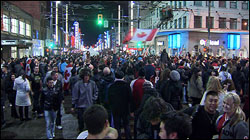 We're one week into the Olympics here in Vancouver and the presence of so many extra bodies is a palpable reality at all times and in every corner of the downtown core. From my apartment, which is nine stories up on a relatively residential street about ten blocks from Robson & Granville (pictured below), you can still hear what sounds a little like Mardi Gras — without the music — at all hours of the day and night.
We're one week into the Olympics here in Vancouver and the presence of so many extra bodies is a palpable reality at all times and in every corner of the downtown core. From my apartment, which is nine stories up on a relatively residential street about ten blocks from Robson & Granville (pictured below), you can still hear what sounds a little like Mardi Gras — without the music — at all hours of the day and night.
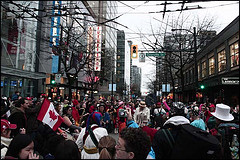 There is a near-constant cacophony of voices from celebratory masses on the move; congregating, mixing and mingling with other groups; the low whine of diesel engines as airport coaches make their rounds and, in the background, the lawn mower-like din of helicopters perpetually circling overhead, ostensibly keeping our airspace secure. I've never been a light sleeper so this is all just mildly amusing to me, but I imagine other residents in my neighborhood might be taking the invasion of their mental environment a little less well (our downstairs neighbor, for example, has an unfortunate inability to tolerate the noise that naturally characterizes communal urban life).
There is a near-constant cacophony of voices from celebratory masses on the move; congregating, mixing and mingling with other groups; the low whine of diesel engines as airport coaches make their rounds and, in the background, the lawn mower-like din of helicopters perpetually circling overhead, ostensibly keeping our airspace secure. I've never been a light sleeper so this is all just mildly amusing to me, but I imagine other residents in my neighborhood might be taking the invasion of their mental environment a little less well (our downstairs neighbor, for example, has an unfortunate inability to tolerate the noise that naturally characterizes communal urban life).
I'll be the first to admit that the Olympics have brought out my inner curmudgeon (we all have one, you know), but the crowds, with their excessive noise and general rowdiness, have even prompted CTV to report the shocking fact that "150,000 revelers in the city's downtown on Friday night were drinking or drunk" (To which residents of the West End collectively responded with a resounding "no shit"). Being out on the streets downtown is a little like being outside the stadium when a playoff game has just let out — only it's New Year's Eve — and homecoming weekend, all at the same time, 24 hours a day for three weeks.
[Photos from the Opening Ceremonies by Peter Millar.]
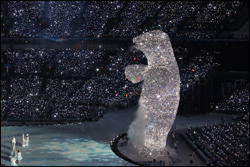 So last Friday night was of course the Opening Ceremonies, which I did watch after spending the first 45 minutes installing and configuring Microsoft's ubiquitous, time-wasting piece of crap known as Silverlight — the same one we installed and uninstalled two years ago that very nearly prevented us from watching the Beijing Opening Ceremonies entirely (luckily we were able to find some German web site streaming them commercial-free, probably illegally). I was pleasantly surprised by the show overall, primarily by the absence of Celine and the lack of any speeches by either BC's embarrassment of a Premiere or our Lizard King Prime Minister.
So last Friday night was of course the Opening Ceremonies, which I did watch after spending the first 45 minutes installing and configuring Microsoft's ubiquitous, time-wasting piece of crap known as Silverlight — the same one we installed and uninstalled two years ago that very nearly prevented us from watching the Beijing Opening Ceremonies entirely (luckily we were able to find some German web site streaming them commercial-free, probably illegally). I was pleasantly surprised by the show overall, primarily by the absence of Celine and the lack of any speeches by either BC's embarrassment of a Premiere or our Lizard King Prime Minister.
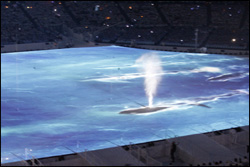 I quite liked the Scottish dancing hooligans and the "I am Canadian" poem — actually entitled "We Are More" by Shane Koyczan — and, as for "standing up to the Beijing OCs," I think they pulled off some very cool visual effects. Most impressive were the giant fiber optic polar bear towering over a tribe of ice age eskimos before melting down and vanishing between the floes of "ice" breaking up beneath its feet, and the pod of Orca whales that appeared to circle just beneath the stadium floor, spouting into the air and breaking the surface of an illusory ocean composed entirely of light and fog.
I quite liked the Scottish dancing hooligans and the "I am Canadian" poem — actually entitled "We Are More" by Shane Koyczan — and, as for "standing up to the Beijing OCs," I think they pulled off some very cool visual effects. Most impressive were the giant fiber optic polar bear towering over a tribe of ice age eskimos before melting down and vanishing between the floes of "ice" breaking up beneath its feet, and the pod of Orca whales that appeared to circle just beneath the stadium floor, spouting into the air and breaking the surface of an illusory ocean composed entirely of light and fog.
[Below: Vancouver reels under "War of the Worlds" onslaught of searchlights and fireworks. All that's missing is Godzilla.]
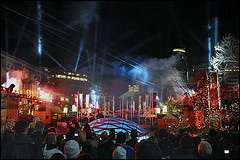 And because I'm a sucker for fireworks of any kind, I very much enjoyed the explosions of red over BC Place in the grand finale; a post-ceremonial money shot, if you will, which I chose to interpret as a humble homage to the spectacular "ring of fire" effects over Beijing's bird's nest in 2008.
And because I'm a sucker for fireworks of any kind, I very much enjoyed the explosions of red over BC Place in the grand finale; a post-ceremonial money shot, if you will, which I chose to interpret as a humble homage to the spectacular "ring of fire" effects over Beijing's bird's nest in 2008.
The next morning I took a break from the Internet and the habit I had fallen into, of vacillating between international news covering anything but Vancouver's preparations for the two-week onslaught and scouring independent media sources for local news about the opposition and their preparations. It wasn't until that afternoon when my dad called from Ontario that I heard that the protests had taken a destructive turn that morning. He wanted to make sure everything was alright in my neck of the woods and that I wasn't going to inadvertantly wander into the fray on a routine trip to the library or something. I assured him that, after getting caught on Robson Street after work Thursday evening, just after the Canadian hockey team won its first game and thousands of fans took to the streets in celebration, I had no intention of getting anywhere near that intersection unless it was absolutely necessary.
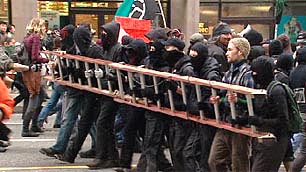 When we got off the phone, I went online to learn more about what had happened up the street from the BBC — which is a weird thing in itself — and to find out if the word riot, which was being thrown around liberally in most of the headlines, was actually warranted. Not surprisingly, it wasn't. In the end, a couple of plate glass windows were broken and seven arrests were made; there was no real violence, no police brutality and no collateral damage. The glass was replaced and the sidewalks swept clean by dinnertime. Later in the day a flash mob erupted near the same intersection and apparently got 2,000 people "dancing in the streets" (not kidding).
When we got off the phone, I went online to learn more about what had happened up the street from the BBC — which is a weird thing in itself — and to find out if the word riot, which was being thrown around liberally in most of the headlines, was actually warranted. Not surprisingly, it wasn't. In the end, a couple of plate glass windows were broken and seven arrests were made; there was no real violence, no police brutality and no collateral damage. The glass was replaced and the sidewalks swept clean by dinnertime. Later in the day a flash mob erupted near the same intersection and apparently got 2,000 people "dancing in the streets" (not kidding).
On Sunday I ventured out with a couple of friends to take in Visceral Bodies, a bit of culture going on at the Vancouver Art Gallery, which included several of Da Vinci's anatomical drawings on loan from the Queen's Royal Collection (although, long story, it's apparently not considered "her" collection anymore, which puts a significant dent in her net worth, in case anyone is keeping score). Alongside Leo, there were several interesting anatomy-themed pieces by contemporary artists, my favorite being a very visceral take on the family portrait. Here's an excerpt from The Vancouver Sun:
"Gabriel de la Mora's Memorial 2, 24.10.07 comprises 17... copies of the skulls of members of his family, including that of his father, who died in 1993, and a stillborn child who died in 1971. The Mexican artist had to get permission to exhume their bodies so he could do MRI scans on them. Each skull is placed at each person's height. At first, I couldn't figure out why the tiny head of the stillborn child was above the other children's heads. Then it struck me: The wee skull is exactly where it would be if its mother were cradling it in her arms. The positioning of the infant's skull to suggest such intimacy made my heart stop." — Kevin Griffin, The Vancouver Sun
All the reviews I've found online seem to have missed my favorite story about this installation, which was related to me by an employee at the art gallery. He overheard me telling my friend the story behind the piece, which I had read about in the Georgia Straight the night before. He pointed out the two left-most skulls in the exhibit and told us that these were the artist and his boyfriend, who was apparently Jewish and had never been fully accepted by the artist's Catholic family. So this was his way of bringing them all together, as they could never be in life. By stripping them of sin and skin, he revealed that they were all one and the same — a family — bound by something deeper than God, beyond even death.
[Below: Stephen Hui's Flickr gallery documents the protests from within.]
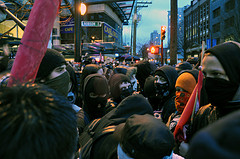 Sunday's excursion into what I thought of at the time as unbelievable crowds was nothing compared to my "commute" to and from work, as all the busses in the downtown core were rerouted or cancelled in response to the massive pedestrian presence. To top it off, I was fighting a cold — which I was only too happy to blame on the crowds as well — and consequently brimming with enough negativity to take a break from my habitual trolling for negative news coverage every night after work. Siding with the protesters had served me well as an antidote to all the pre-Olympics proselytizing but it seemed like, after their first taste of genuine conflict, when the protesters found themselves marching not so much against riot cops as legions of sports fans, their opposition disappeared in a puff of rose-colored smoke.
Sunday's excursion into what I thought of at the time as unbelievable crowds was nothing compared to my "commute" to and from work, as all the busses in the downtown core were rerouted or cancelled in response to the massive pedestrian presence. To top it off, I was fighting a cold — which I was only too happy to blame on the crowds as well — and consequently brimming with enough negativity to take a break from my habitual trolling for negative news coverage every night after work. Siding with the protesters had served me well as an antidote to all the pre-Olympics proselytizing but it seemed like, after their first taste of genuine conflict, when the protesters found themselves marching not so much against riot cops as legions of sports fans, their opposition disappeared in a puff of rose-colored smoke.
If I've learned anything this week, fighting my way through the ranks of the converted — 150,000 strong, comprised of wannabes in red sweatshirts with maple leaves painted on their faces, and drunken idiots draped like caped crusaders in Canadian flags, waving banners and beer bottles as they scream in the streets — it's that the issues never stood a chance once the games were underway. It's the classic jocks versus nerds dynamic and nerds never prevail by adopting the jocks' mindless approach, by resorting to brute force and in-your-face aggression (masked or otherwise). Make no mistake, though; the nerds always prevail.
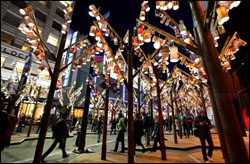 As it turns out, I wasn't far off in my assessment. Chris Shaw spoke with The Vancouver Observer in an interview entitled "Protests, Black Bloc, and the Future of Anti-Olympic and Other Activist Organizing in Vancouver." The article was posted on Friday but when I tried to find it again tonight, it was literally nowhere on their site, or anywhere else. In it, he had expressed ambivalence about the fractious effects last Saturday's events were already having on the anti-Olympics movement. He avoided condemning the protesters who were responsible for the escalation towards violence, but said he couldn't support property damage done seemingly for its own sake. He also said he regretted that all protesters were now conflated in the eyes of the media — and by extension the public — with senseless vandalism. Most of all, he said that he would hate to see the last seven years of organizing and community-building evaporate as a result of the tactics of a few dissenters, which were threatening to derail everything the majority had come so close to achieving.
As it turns out, I wasn't far off in my assessment. Chris Shaw spoke with The Vancouver Observer in an interview entitled "Protests, Black Bloc, and the Future of Anti-Olympic and Other Activist Organizing in Vancouver." The article was posted on Friday but when I tried to find it again tonight, it was literally nowhere on their site, or anywhere else. In it, he had expressed ambivalence about the fractious effects last Saturday's events were already having on the anti-Olympics movement. He avoided condemning the protesters who were responsible for the escalation towards violence, but said he couldn't support property damage done seemingly for its own sake. He also said he regretted that all protesters were now conflated in the eyes of the media — and by extension the public — with senseless vandalism. Most of all, he said that he would hate to see the last seven years of organizing and community-building evaporate as a result of the tactics of a few dissenters, which were threatening to derail everything the majority had come so close to achieving.
Ah, here it is — a scan through my browser history finally turned up that Observer interview. Weird. Anyway, Chris Shaw can also be seen at rabble.ca discussing his views at an anti-Olympics meeting Wednesday night; next to him is David Eby, who spoke as well, pausing frequently as his voice was drowned out by "Black Bloc" supporters who were angered by his characterization of their tactics as destructive to the movement. The Tyee has also posted an article entitled "Pie in Face Signals Split in Olympics Protest Movement" that describes all sides of the argument, while "Building Blocs: Olympics Resistance Chooses a Diversity of Tactics," an article by Moira Peters, gives a beautifully written blow-by-blow account of Saturday's events from a very different perspective. Lastly, a blogger called Cathy from Canada (no relation) has an interesting — and from what I can tell, novel — assessment of what may ultimately prove to be the anti-Olympic movement's Achilles heel, or so it appears at this moment, anyway, here at the exact midpoint of the biggest event in Vancouver's brief history.
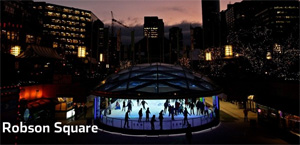 With less than a week to go before the official start of the 2010 Olympics, the transformation/takeover of Vancouver is becoming more evident and less avoidable with each passing day. Bus routes have been redrawn and rescheduled to avoid pedestrian "event" areas downtown, including several blocks in the middle of Robson Street, our main shopping drag, where Olympic installations have effectively taken over with a public skating arena and four corner-spanning "zipline" ride (see our, ahem, distinguished Premier Gordon Campbell testing it out here).
With less than a week to go before the official start of the 2010 Olympics, the transformation/takeover of Vancouver is becoming more evident and less avoidable with each passing day. Bus routes have been redrawn and rescheduled to avoid pedestrian "event" areas downtown, including several blocks in the middle of Robson Street, our main shopping drag, where Olympic installations have effectively taken over with a public skating arena and four corner-spanning "zipline" ride (see our, ahem, distinguished Premier Gordon Campbell testing it out here).
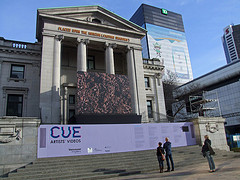 On the opposite side of the street we have the Art Gallery, the front steps of which are usually home to a motley assortment of protesters and pot dealers, jewelry vendors, performers and artists, with their drawings, paintings and/or homemade quilts encroaching towards the sidewalk. The entire facade is now barricaded with what appears to be a wall of blast-resistant steel, periodically shrouded in descriptive signage, and a huge screen upon which various art exhibitions are projected day and night. When I walked by last week, a dizzying barrage of photographs were on display, flashing for less than a second each, like some kind of frenetic, seizure-inducing form of mass subliminal indoctrination, a la The Parallax View (1974) or the "blipverts" of Max Headroom (1987).
On the opposite side of the street we have the Art Gallery, the front steps of which are usually home to a motley assortment of protesters and pot dealers, jewelry vendors, performers and artists, with their drawings, paintings and/or homemade quilts encroaching towards the sidewalk. The entire facade is now barricaded with what appears to be a wall of blast-resistant steel, periodically shrouded in descriptive signage, and a huge screen upon which various art exhibitions are projected day and night. When I walked by last week, a dizzying barrage of photographs were on display, flashing for less than a second each, like some kind of frenetic, seizure-inducing form of mass subliminal indoctrination, a la The Parallax View (1974) or the "blipverts" of Max Headroom (1987).
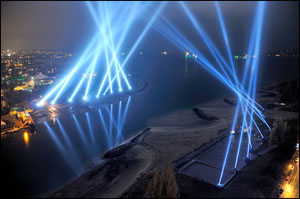 Then there's the massive installation of 20 spotlights flanking English Bay — paging schitzo-Batman — which are reconfigured every few minutes based on designs that people submit via web site. It runs from dusk till dawn so our living room windows are regularly strafed by spears of white-blue light flashing by on their way to the next configuration. Believe it or not, this over-the-top display of Olympic ostentation is the one I find least intrusive. In fact, it's made me miss our old apartment more than ever, since you can clearly see the building in most of the photos, situated right between the fourth and fifth spotlight on the north bank of English Bay.
Then there's the massive installation of 20 spotlights flanking English Bay — paging schitzo-Batman — which are reconfigured every few minutes based on designs that people submit via web site. It runs from dusk till dawn so our living room windows are regularly strafed by spears of white-blue light flashing by on their way to the next configuration. Believe it or not, this over-the-top display of Olympic ostentation is the one I find least intrusive. In fact, it's made me miss our old apartment more than ever, since you can clearly see the building in most of the photos, situated right between the fourth and fifth spotlight on the north bank of English Bay.
[Below: In front of the Library, an art installation which I don't get.]
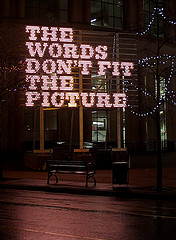 It was about a week ago that I started to really notice the presence of out-of-town visitors on a massive scale. There are differences in fashion sense, demographics and behavior that, to a local, seem as obvious as the surge in exotic accents one overhears. For example, there are the pairs of ladies with their heads angled forward and scarves streaming from their necks, conversing excitedly as they walk briskly by; the trios of older men walking down the street dressed far more fashionably — expensively even — in the middle of the day than their local counterparts; and the clusters of young white guys in gangster attire (we have these, too, they're just not predominantly white). The influx of men from out of town is probably most obvious to the women who live here due to the noticeable increase in male attention — appreciative glances, eye contact and even unsolicited compliments from complete strangers — none of which are everyday occurrences in downtown Vancouver.
It was about a week ago that I started to really notice the presence of out-of-town visitors on a massive scale. There are differences in fashion sense, demographics and behavior that, to a local, seem as obvious as the surge in exotic accents one overhears. For example, there are the pairs of ladies with their heads angled forward and scarves streaming from their necks, conversing excitedly as they walk briskly by; the trios of older men walking down the street dressed far more fashionably — expensively even — in the middle of the day than their local counterparts; and the clusters of young white guys in gangster attire (we have these, too, they're just not predominantly white). The influx of men from out of town is probably most obvious to the women who live here due to the noticeable increase in male attention — appreciative glances, eye contact and even unsolicited compliments from complete strangers — none of which are everyday occurrences in downtown Vancouver.
In a recent Sports Illustrated article, Dave Zirin addressed the sense of "dread" that most Vancouver residents are feeling as the Olympics draw nearer, citing the massive budget overruns, draconian laws threatening citizens' rights to freedom of speech and assembly, as well as government spending cuts in education and housing. Douglas Haddow's article for the Guardian UK summarizes the city's ambivalence towards the upcoming spectacle quite nicely, despite the histrionics suggested by its headline: "Vancouver's Olympics head for disaster."
"Conservative estimates now speculate that the games will cost upwards of $6bn, with little chance of a return. This titanic act of fiscal malfeasance includes a security force that was originally budgeted at $175m, but has since inflated to $900m. With more than 15,000 members, it's the largest military presence seen in western Canada since the end of the second world war, an appropriate measure only if one imagines al-Qaida are set to descend from the slopes on C2-strapped snowboards. With a police officer on every corner and military helicopters buzzing overhead, Vancouver looks more like post-war Berlin than an Olympic wonderland. Whole sections of the city are off-limits, scores of roads have been shut down, small businesses have been told to close shop and citizens have been instructed to either leave the city or stay indoors to make way for the projected influx of 300,000 visitors." — Douglas Haddow, guardian.co.uk
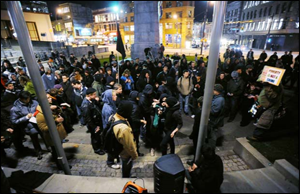 The Integrated Security Unit, determined to give the city its billion dollars' worth, has sent its enforcers out to the homes, workplaces and even grocery stores of local activists to "speak with" them about their planned activities during the Olympics, apparently more concerned that hippies wielding protest signs might be caught on camera while "the world is watching" than the possibility that actual terrorists might take issue with the fact that Canada still has troops on the ground in Afghanistan.
The Integrated Security Unit, determined to give the city its billion dollars' worth, has sent its enforcers out to the homes, workplaces and even grocery stores of local activists to "speak with" them about their planned activities during the Olympics, apparently more concerned that hippies wielding protest signs might be caught on camera while "the world is watching" than the possibility that actual terrorists might take issue with the fact that Canada still has troops on the ground in Afghanistan.
The Vancouver Observer published an article today about a local chemical company that transports 82 metric tonnes of pressurized liquid chlorine an average of six times per day by rail through the heavily populated Lower Mainland. The company, Canexus Chemicals Canada, "will close for at least four weeks... during the 2010 Games," for upgrades, according to Megan Stewart. Although Canexus would not confirm whether there was a connection between the timing of their upgrades and the games, it's very possible (and somewhat comforting) that the "probability of a terrorist action against a railcar" was too big a threat for the ISU to ignore.
As for me, I have no plans but to stay as far away from any events or "Olympic routes" as possible. I'm dreading the three-week orgy of nationalistic consumerism and the atmosphere of forced mania as an entire city panders to the world's elites and their disposable dollars. I'll have my hands full enough trying to figure out how to get to work, the drug store and the library in the choking congestion of 300,000 additional sports fans on a 24-7 testosterone-fueled out-of-town bender. (And yes, that's sports — plural — for fuck's sake.)
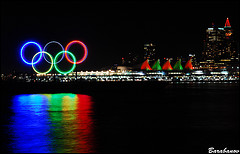 The whole question of whether subjecting the world's most livable city to the scrutiny of global media, and shining a spotlight on its biggest social problems — 3,000 homeless, a marginalized Native community and the whole Downtown Eastside drugs, poverty and prostitution clusterfuck — will merely go down as the dark shadow side of all this Olympic propagandizing, or whether the threat of same will somehow spur local and Provincial governments to work together to actually solve some of these problems, is anybody's guess. If this were any other city — Atlanta, for instance, or Beijing — I'd say bring on the goons from the ISU because I'm with the protesters... if not in the streets, then at least in spirit. (Honestly, who wants to be on the receiving end of an Olympic-strength Tasering?)
The whole question of whether subjecting the world's most livable city to the scrutiny of global media, and shining a spotlight on its biggest social problems — 3,000 homeless, a marginalized Native community and the whole Downtown Eastside drugs, poverty and prostitution clusterfuck — will merely go down as the dark shadow side of all this Olympic propagandizing, or whether the threat of same will somehow spur local and Provincial governments to work together to actually solve some of these problems, is anybody's guess. If this were any other city — Atlanta, for instance, or Beijing — I'd say bring on the goons from the ISU because I'm with the protesters... if not in the streets, then at least in spirit. (Honestly, who wants to be on the receiving end of an Olympic-strength Tasering?)
But it is Vancouver. We've got guys like Chris Shaw speaking eloquently and convincingly against the games and on behalf of the protesters, not just in all the local papers like The Vancouver Sun and Georgia Straight, but to an international audience with interviews in The Guardian and Huffington Post. On the legal front, we have David Eby, Executive Director of the B.C. Civil Liberties Association, outspoken advocate for the homeless and critic of the Olympics. He is "helping to establish the first ever team of independent legal observers at an Olympic Games [and] was one of ten members of Vancouver's Mayor's Homeless Emergency Action Team, which opened 400 temporary shelter beds this past winter." Vancouver Magazine listed Eby among their Power 50 in 2009, calling him "the city's social conscience."
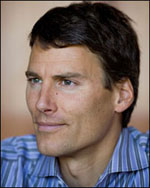 Finally, there's our Mayor Gregor Robertson, entrepreneur and co-founder of Happy Planet organic juices, he was elected in November 2008 "on a platform of ending street homelessness in the City of Vancouver by 2015, and making Vancouver the greenest city in the world." In addition to being absurdly cute, wholesome and charming, like a department store catalog model in some sustainable alternate universe, Robertson has a sort of pre-election Obama effect on people, giving them hope and making them want to get out there and help him bring about change.
Finally, there's our Mayor Gregor Robertson, entrepreneur and co-founder of Happy Planet organic juices, he was elected in November 2008 "on a platform of ending street homelessness in the City of Vancouver by 2015, and making Vancouver the greenest city in the world." In addition to being absurdly cute, wholesome and charming, like a department store catalog model in some sustainable alternate universe, Robertson has a sort of pre-election Obama effect on people, giving them hope and making them want to get out there and help him bring about change.
So who knows? In the feverish meantime, I'll be hiding out in my living room, reading the latest updates from the front lines of the world's most livable police state at The Observer, taking the road less traveled through the residential West End to get to work, and most likely tuning in to watch the opening ceremonies online — just to see how they stand up to Beijing's apocalypse of lights at the 2008 games — and then turning them off the minute Celine Dion appears.
 One of the best things I discovered after moving back to Canada 13 years ago is that the National Film Board of Canada, historically and currently, is responsible for producing a huge proportion of the world's best independent and documentary films. Since its founding in 1939, the Board has garnered awards, respect and recognition from the international community and their web site is an amazing continuation of their guiding principles, offering hundreds of films free online and thousands for sale. There is also a wealth of resources for directors, producers and emerging filmmakers wishing to apply for grants and sponsorships and connect with like minded creatives.
One of the best things I discovered after moving back to Canada 13 years ago is that the National Film Board of Canada, historically and currently, is responsible for producing a huge proportion of the world's best independent and documentary films. Since its founding in 1939, the Board has garnered awards, respect and recognition from the international community and their web site is an amazing continuation of their guiding principles, offering hundreds of films free online and thousands for sale. There is also a wealth of resources for directors, producers and emerging filmmakers wishing to apply for grants and sponsorships and connect with like minded creatives.
Over the last few days I've watched a handful of short films — not usually my favorite medium but there are some good ones — and "interactive" offerings like RIP: A Remix Manifesto and Waterlife, an amazing virtual tour illustrating through audio, video and infographics the fragile ecosystem that is the Great Lakes. As ingenious as the interactive design is, it never distracts from the film's narrative underpinnings or diffuses the impact of the many small stories it tells; of the pollutants and chemicals that poison the waters, the new invasive species that have taken hold or the increasing prevalence of cancer and genetic defects that plague nearby communities, to name just a few.
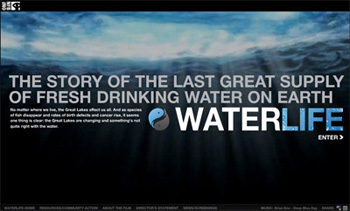 "From the icy cliffs of Lake Superior to the ornate fountains of Chicago to the sewers of Windsor, this feature-length documentary tells the story of the last huge supply (20%) of fresh water on Earth."
"From the icy cliffs of Lake Superior to the ornate fountains of Chicago to the sewers of Windsor, this feature-length documentary tells the story of the last huge supply (20%) of fresh water on Earth."
— OurWaterlife.com
I had to go on an infographic binge after watching Waterlife and one of the best places I've found to indulge that urge is GOOD Magazine.
 One of their Most Popular Infographics of 2009 is called Walk This Way: Making the right choices to reduce your water footprint. It includes such vital statistical data as which alcoholic beverage is more water-intensive, beer or wine. To my personal dismay, they don't mention vodka... but maybe what I don't know won't hurt me. Strange omissions abound, once you start analyzing it; like why they choose to contrast the water usage of a typical bath, not with a timed shower but with "no bath," which for most of us would be a grim non-option at best.
One of their Most Popular Infographics of 2009 is called Walk This Way: Making the right choices to reduce your water footprint. It includes such vital statistical data as which alcoholic beverage is more water-intensive, beer or wine. To my personal dismay, they don't mention vodka... but maybe what I don't know won't hurt me. Strange omissions abound, once you start analyzing it; like why they choose to contrast the water usage of a typical bath, not with a timed shower but with "no bath," which for most of us would be a grim non-option at best.
Other GOOD favorites of mine include the "transparencies" (infographics) Where Are All the Fish? and America's Problem Drugs. In case all that sounds too depressing, there is also The GOOD 100, "a collection of the most important, exciting, and innovative people, ideas, and projects making our world better."
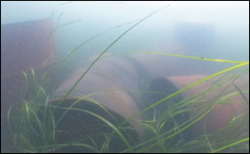 Watching Waterlife made me think about this other documentary we saw last year called Buried at Sea, coincidentally also brought to us by the NFB, about the "massive stockpiles of unused weapons dumped into the ocean by Canada, the United States, Britain, the Soviet Union and Germany after WWII and during the Cold War."
Watching Waterlife made me think about this other documentary we saw last year called Buried at Sea, coincidentally also brought to us by the NFB, about the "massive stockpiles of unused weapons dumped into the ocean by Canada, the United States, Britain, the Soviet Union and Germany after WWII and during the Cold War."
[You can watch Buried at Sea on Google Video.]
Although the film takes its viewers all over the world in search of these long-buried and mostly forgotten hazards, much of the focus is on Canada's contribution to the problem, since Canada was the number one producer of chemical weapons during WWII. Most of those weapons were never deployed and, when the war was over, the government ordered them destroyed. The safest method at the time was thought to be disposal at sea (you know, what with the sea being infinite and all) so thousands of canisters of mustard gas and millions of rounds of unused ordinance and explosives were dumped within a thousand miles of the shore on the east coast. Coincidentally, this is where the vast majority of the fish consumed in North America comes from — correction, came from, before fish stocks in the North Atlantic collapsed completely over the last few decades.
Not that the rest of the world was any better; the British government saw no potential downside to disposing of nearly 2 million tons of munitions and several tons of chemical and radioactive materials in Beaufort's Dyke, a trench in the Irish Sea between Scotland and Northern Ireland. The Baltic Sea was a dumping ground for enormous quantities of chemical agents stockpiled by the Nazis before the end of the war, including sarin and phosgene as well as Zyclon-B, the gas we're talking about when we refer to the gas chambers.
 After seeing that documentary, I was so interested in the topic that I borrowed Poison in the Well: Radioactive Waste in the Oceans at the Dawn of the Nuclear Age by Jacob Darwin Hamblin from the library and renewed it several times. After two months, I was still only halfway through it and progressing at just a few pages per night. It's an incredibly academic treatment of the subject matter, as fascinating a subject as it is. I finally gave up and returned it but later found it online as a PDF (don't ask me how — I was as shocked as anyone that it was out there for the downloading) so now I plan on having my Mac read it to me at a more respectable pace.
After seeing that documentary, I was so interested in the topic that I borrowed Poison in the Well: Radioactive Waste in the Oceans at the Dawn of the Nuclear Age by Jacob Darwin Hamblin from the library and renewed it several times. After two months, I was still only halfway through it and progressing at just a few pages per night. It's an incredibly academic treatment of the subject matter, as fascinating a subject as it is. I finally gave up and returned it but later found it online as a PDF (don't ask me how — I was as shocked as anyone that it was out there for the downloading) so now I plan on having my Mac read it to me at a more respectable pace.
I also found this in-depth and very readable article called WMDs on Our Doorstep which details the widespread ocean disposal of weapons caches after WWII and contains links to maps of disposal sites off the coasts of the United States, Asia, Europe and Australia. Lastly and most recently, this concise 6-minute video was created by the James Martin Center for Nonproliferation Studies using Google Earth to map all the known dump sites in the world and what was dumped there: